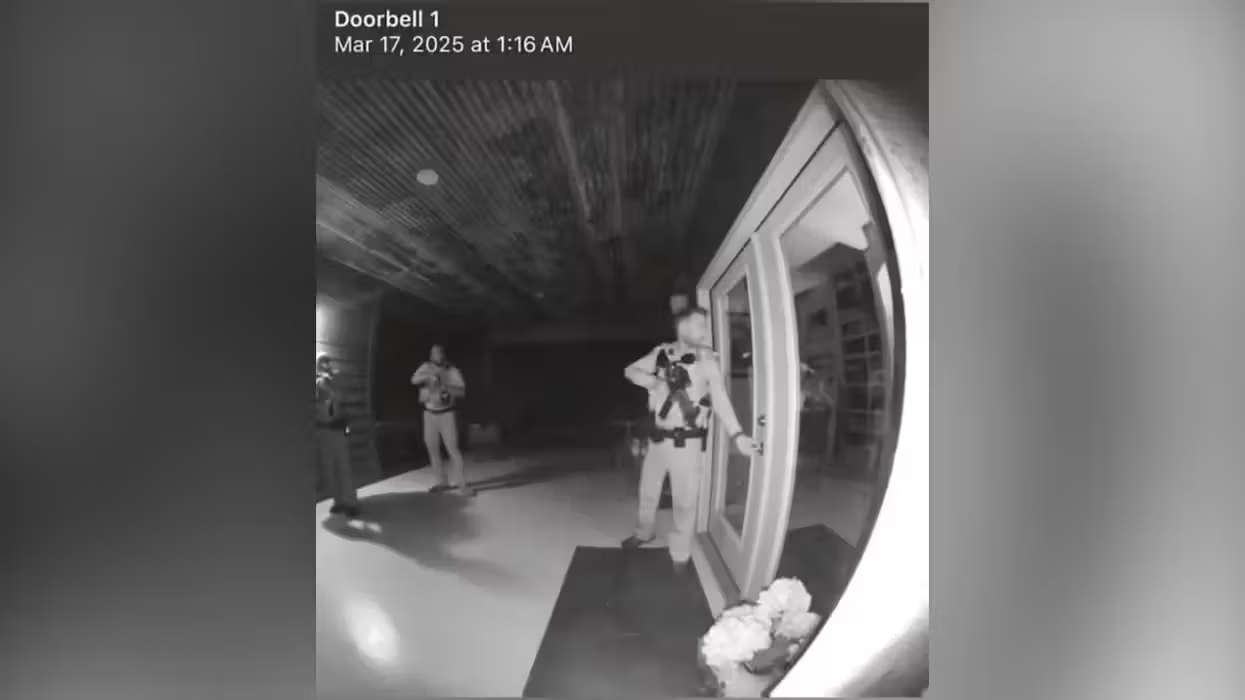
© 2025 Blaze Media LLC. All rights reserved.
Blaze Magazine Exclusive: Skyrocketing Tuition and Student Debt Threaten the U.S. Economy
November 08, 2012
With Americans owing more than $1 trillion in student loans, the country could be faced with economic upheaval if a growing bubble filled with education debt bursts onto the backs of taxpayers.
Editor’s note: Every issue of TheBlaze Magazine, contains exclusive content not found anywhere else—online or in print. The magazine’s stories, research and special reports are reserved for subscribers to the print edition (and, yes, there is a digital version of the magazine that works on your mobile devices, too), which is created by the same team that brings you TheBlaze.com.
In her feature story, "Higher Red," for the November 2012 issue, TheBlaze Magazine Assistant Editor Sharon Ambrose examines skyrocketing college tuition rates and soaring student debt. What's behind the higher costs? Will massive debt impact the U.S. economy? Is the price of admission even worth it anymore?
Below is an excerpt from Sharon's report, available only in the November 2012 issue of TheBlaze Magazine.
-----------
Will graduating with a college degree maintain its standing within the American Dream, or will the reality of rising tuition prices and low job prospects ignite an economic nightmare? With Americans owing more than $1 trillion in student loans, the country could be faced with economic upheaval if a growing bubble filled with education debt bursts onto the backs of taxpayers.
When that happens, will academia respond by offering more affordable options, or will progressives use the instability to move America’s colleges and universities towards a European-like universal (read: single-payer) system?
TUITION INFLATION: WHERE DOES THE MONEY GO?
The price tag for a bachelor’s degree has risen at an incredible rate, even faster than that of health care. Health care rates rose 150 percent between 1990 and 2011. During that same time period, four-year college tuition rates skyrocketed 300 percent, not including room and board, according to Moody’s Analytics. Public universities are raising their prices at an alarming rate to make up for beleaguered state budgets.
In 2011, annual tuition and fees at U.S. public universities rose 8.3 percent from the previous year to an average of $8,244, a jump that is twice the rate of inflation, as reported by the College Board. Throw in room and board, and the average cost of attending a public university for a year is $17,131, a 6 percent jump over the course of 12 months. Likewise, the annual tab for private college grew 4.5 percent to an average of $28,500—or $38,589 with room and board.
While college enrollment between 1987 and 2007 increased 40 percent, support staff increased 200 percent, according to the Center for College Affordability and Productivity (CCAP). A CCAP report found that the expansion of staff positions came from jobs that were not in existence decades earlier, including environmental sustainability officers, IT workers, loan counselors and office support staff tasked with keeping up with changing regulations.
 University leaders have also seen their earnings inflate. According to 2011 study by The Chronicle of Higher Education, between the academic years of 1999-2000 to 2009-10, average presidential pay at the 50 wealthiest universities increased 75 percent to $876,792.
University leaders have also seen their earnings inflate. According to 2011 study by The Chronicle of Higher Education, between the academic years of 1999-2000 to 2009-10, average presidential pay at the 50 wealthiest universities increased 75 percent to $876,792.
The average salary of a professor at these same universities increased an average of 14 percent to $179,970. By comparison, the U.S. Census Bureau reported that in 2010 the median household income in the United States was just shy of $50,000. Today, the average salary of tenured professors at private and public universities stands at $162,561 and $120,955, respectively, based on a survey by the American Association of University Professors (AAUP).
Even though tenured faculty do enjoy above-average salaries, higher tuition fees are not necessarily going toward professors’ salaries.
The AAUP reports that, in 2009, more than half of instructional staff was made up of non-tenure-track faculty such as adjunct instructors. The national average earnings of adjunct instructors in the United States is just under $2,500 per course. By employing part-time instructors, colleges are able to continue to fill class rosters and put the savings toward updating campus amenities.
 The Delta Cost Project at the American Institutes for Research reports that between 1999 and 2009 private colleges and universities increased spending on student services—admissions departments, financial aid administration, student organizations, intramural athletics, etc.—32 percent while spending on instruction rose 13 percent.
The Delta Cost Project at the American Institutes for Research reports that between 1999 and 2009 private colleges and universities increased spending on student services—admissions departments, financial aid administration, student organizations, intramural athletics, etc.—32 percent while spending on instruction rose 13 percent.
Cornell University professor Ronald Ehrenberg studied tuition inflation and concluded, “Top institutions have chosen to maintain and increase quality largely by spending more, not by increasing efficiency, reducing costs, or reallocating funds.”
Internal politics also plays a significant role in hiking tuition. Ehrenberg noted, “Administrators at private institutions often find that all blame for cutbacks is assigned to them. Rather than risk the goodwill of the faculty, whose support they need to effectively govern, they are more likely to agree to raise tuition than take other actions to provide budget relief.”
[...]
THE NEXT BUBBLE TO BURST?
Andrew Gillen, research director of the CCAP, argues that the most telling trait of a bubble in any industry is “uncertainty as to the true value of the good.” Recent polling indicates that Americans are indeed questioning the value of a college education. According to a survey published by Country Financial in July, only 57 percent of adults believe that a college education is a good investment, a stark contrast to the 81 percent who felt the same way in 2008.
A 2011 Pew Research Center survey found that 57 percent of Americans “say the higher education system in the United States fails to provide students with good value for the money.” Seventy-five percent believe that “college is too expensive for most Americans to afford.” ...
Thirty-three percent of parents surveyed in 2010 admitted that they would send their child to college for the “intellectual and social experience” without regard to the level of future income generated because of that college degree. When asked the same question one year later, only 24 percent of parents still held this belief.
That’s a pretty sobering state of uncertainly. ...
[...]
WILL THEY LET A CRISIS GO TO WASTE?
 Progressives eager for universal higher education systems like that found in Europe may take advantage of this crisis to push through major changes. At a Senate subcommittee hearing in March, Democratic Sen. Dick Durbin, Ill., argued in favor of discharging educational debt. “There is no reason why private studenT loans should get treated differently from other private debt in bankruptcy,” he said. “And it is especially egregious that these private loans are non-dischargeable in cases where a student was steered into the loan while the student was eligible for safer federal loans.”
Progressives eager for universal higher education systems like that found in Europe may take advantage of this crisis to push through major changes. At a Senate subcommittee hearing in March, Democratic Sen. Dick Durbin, Ill., argued in favor of discharging educational debt. “There is no reason why private studenT loans should get treated differently from other private debt in bankruptcy,” he said. “And it is especially egregious that these private loans are non-dischargeable in cases where a student was steered into the loan while the student was eligible for safer federal loans.”
In June, a million petitioned signatures were delivered to Democratic Rep. Hansen Clarke, Mich., in support of his drafted legislation, the Student Loan Forgiveness Act. If passed into law, Stafford loan interest rates would be placed at 3.4 percent indefinitely. Also, graduates currently repaying loans based on a sliding scale system would pay no more than 10 percent of their discretionary income toward federal loans, currently they pay 15 percent. In addition, instead of having to work 10 years in the public sector to take advantage of the Public Service Loan Forgiveness program, this proposed legislation would cut down the work requirement to five years. While the chances of Clarke’s legislation actually passing appear slim, it provides a clear signal for which direction progressives would like to push the higher education system.
[...]
Get the exclusive feature, including full analysis on the state of tuition rates and student loans, how those things impact the economy, the ugly truth about Pell Grants, progressives' master plan for college education and more, only in the pages of the newest issue of TheBlaze Magazine.
Want to leave a tip?
We answer to you. Help keep our content free of advertisers and big tech censorship by leaving a tip today.
Want to join the conversation?
Already a subscriber?
more stories
Sign up for the Blaze newsletter
By signing up, you agree to our Privacy Policy and Terms of Use, and agree to receive content that may sometimes include advertisements. You may opt out at any time.
Related Content
© 2025 Blaze Media LLC. All rights reserved.
Get the stories that matter most delivered directly to your inbox.
By signing up, you agree to our Privacy Policy and Terms of Use, and agree to receive content that may sometimes include advertisements. You may opt out at any time.





